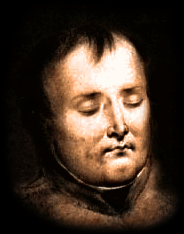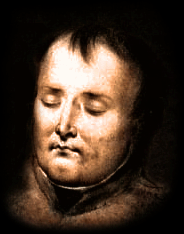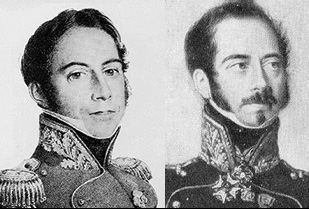Bruno Roy-Henry, le 5 mai 2002
Historien
17 000 – La Rochelle
Lieutenant-Colonel Chaduc
Conservateur du département 1789-1871
Musée de l’Armée
PUBLIC LETTER TO
Lieutenant-Colonel CHADUC
Dear Colonel,,
[... ], I took note of your position on the history of the death masks of the Emperor Napoleon Bonaparte.
You write:
"Since the death of Napoleon Bonaparte on the 5th of May, 1821, there have been many death masks of which the most genuine ones are the masks known as "helenian". Then there are a certain number of true mouldings, which were carried out later in Europe and which are very rare; finally there is a large quantity of apocryphal masks from all sorts."
Nothing is less certain! The “helenian” masks (i.e. of Antommarchi type) are not necessarily the most genuine ones and it is far from being proven that they were moulded at St. Helena.
Mask of Antommarchi type
"the creation of the mask, or more exactly, the creation of the print, was carried out on the 7th of May by Doctor Burton (...) assisted by Dr. Antommarchi (...) with a plaster of bad quality coming from the island. The print was taken in three parts: a central part known as facial, taken from middle of the forehead to the lower part of the mouth, a second part including the chin, the neck and sides of the head, and finally a third part that included the top of the forehead and the higher and front parts of the skull.”
This assertion is far from being proven: it is the theory from Baron de Veauce, obligingly followed by your predecessors. No detail is here to prove that the death mask of the Emperor comprised three parts: quite to the contrary! It results from the testimony of Doctor Graves, a cousin of Burton (he had Burton Papers and published them in "London Medical and Surgical Journal" of the 18th of July, 1835, according to de Veauce in “L’affaire du masque mortuaire de Napoléon”, p. 64) that the print of the face, carried out on May 7th at 4 P.M. had the following limits: "(...) Only the mask, i.e. the moulding which comprises the face, the ears and of the higher part of the forehead and without going behind the chin (...)".
Consequently, there was another part of the mask that included the former and posterior parts of the skull, for which Antommarchi gave his assistance. It is the obviousness; moreover, to carry out the moulding of the head of a defunct person in two parts is in conformity with the technique still employed today. Consequently, the assertion that the mask of Napoleon comprised three parts is not only to ignore historical testimonials but is also to be unaware of the particular technique of facial moulding !
"on the 8th of May, when Burton wants to undertake a first moulding of the print he had made, he realized that the central part disappeared. In fact, it had been stolen by Madame Bertrand (...) in order to give it in Antommarchi. Finally, Burton quickly leaves the island with the two remaining parts (note: no, see below). Antommarchi, who remained at St. Helena, then undertakes to reconstitute the first moulding of the death mask of Napoleon with the only facial part. To reconstitute the missing parts, Antommarchi uses the services of Rubidge, young English artist on a passage to the island, who had carried out sketches of Napoleon on his deathbed. Here is therefore the probable origin of the masks of the Antommarchi type from which other mouldings were carried out at St. Helena even before the return of Antommarchi to Europe "
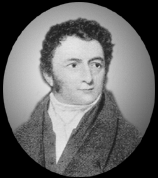
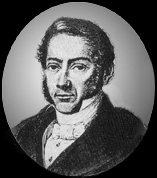 Doctor Burton
Doctor Antommarchi
Doctor Burton
Doctor Antommarchi
All this is purely conjectural! Nothing makes it possible to affirm that Antommarchi carried out his tests while at St. Helena… What is sure and proven, is that he had the facial print of Napoleon, or more exactly the facial mask, i.e. this print taken by Burton and concealed from him by Countess Bertrand. On this matter, the testimony of Saint-Denis (known as Ali) is capital:
"I do not know why Antommarchi did not make the frontal part of the head; he had however drawn the mould from it. What I know, it is that the doctor, after having drawn the mould from the face, destroyed this one in order to prevent other prints to be taken from it. This destruction which, truly, was an act of vandalism, is all the more regrettable because on this mould [the original print] there remained lashes from the eyelids and hairs from the eyebrows. Antommarchi probably had reasons to have done thus, but whatever those had been, they were bad, since they deprived the posterity of a priceless item."
Saint-Denis is an eyewitness of the events. Admittedly, he does not tell everything or does not know the whole truth... Moreover, he must remain loyal to his companions in exile; he cannot thus condemn the intrigues of Antommarchi. But his reprobation bursts in each line: "this destruction was an act of vandalism (...) they deprive [note: his bad reasons] the posterity of a priceless item."
Actually, we understand very well that Antommarchi, on the order from Madame Bertrand, seized the facial mask of the Emperor to prevent his use by Burton. Was it done for poor financial reasons? No, the aim was to prevent the spreading of an image of the Emperor considered to be too ugly. As Ali stated:
"It is quite regrettable that nobody did think earlier of taking the mask, because, by the 7th of May, the flesh had already become too soft to obtain a regular print of the features".
Let us take again the testimony of Marchand, six hours after the death of the Emperor: "The doctor [Antommarchi] arranged the chin bandage again that we had withdrawn during the wash for the lay out of the corpse; at this stage the Emperor had his figure of Consul. The slightly contracted mouth gave to his figure an air of satisfaction; he did not appear to have more than thirty years (...). The calm of this figure let believe he was in a sleep rather than dead. If, at that moment we had taken the plaster, it would have appeared much better than that the one taken two days after... "
après… »
Isn't that enough of a proof? And here is what Bertrand says (in “Cahiers de St. Helena, January-May 1821”, p.196, at the 6th of May): "At eight o’clock, we decided to make the plaster from the face of the Emperor, but we did not have what was needed. The face of the Emperor then appeared even younger than he actually was: he seemed to be approximately forty years old [note: the more time passes and the more the features of the face break up]. At four o’clock in the evening [note: this was still on May 6, but eight hours later], he had an air older than he actually was."
And now, the final avowal from Bertrand: "A four o’clock [note: 16h on the 7th of May 7, hence about 24 hours later], we made the plaster of the face of the Emperor, who was VERY DISFIGURED and exhaled a very bad smell (ibid: p.199)".
Under these conditions, how to believe that the Antommarchi mask - even for its facial part – is genuine? It is obviously an assembly, or maybe a modelling, hence it is a fraud and an imposture! The aspect of this mask reflects the features of a man who does not look more than forty-year old. This feature of the Emperor would have been possible on May 6th, but became impossible on May 7th: at best, one will obtain the image of a man of about sixty-year old. It is enough to read from the eye-witnesses to accept such obviousness!
«
"Four “helenian" masks are known:
: the mask called "Burguersh" which is the specimen exhibited to the museum of the Army. This mask appeared at the time of the succession of Mrs Pink Weigall, daughter of Lord Burguesh. Under the base of the mask was an English scriptural note: "This moulding of the head of Napoleon
[note: we have just shown that this is completely untrue] was taken at St. Helena, after his death by Doctor Antommarchi, the Italian doctor who was attached to him, and dispatched by his care (by the channel of the English authorities) to Lord Burguersh then British minister with Florence for the use by Canova the sculptor. This one restored it then and Antommarchi offered it to Lord Burguersh".
Which historical value can have this account? None! Baron de Veauce tried by erudite digressions to establish the historical truth of this account. Firstly, let us state that its origin is indifferent: it does not matter that the author is an English duchess or not! Already, it is established that only the moulding of the only face could “possibly” be authentic! Moreover, Rose Weigall, intentionally or not, wanted us to believe that the Corsican doctor had addressed the original genuine moulding to Canova to enable him to immortalise it in the marble; and this, by the channel of Lord Burguersh. So let’s make it clear: there has never been a single proof of this; there is no trace in the writings of Canova, who died in 1822! No testimony from his apprentices and assistants either. And, can we believe that Antommarchi would have easily offered this unique relic to the English minister? This story can only be a pure fantasy!
« "Thereafter, this mask was bought by Baron de Veauce. Its surface shows multiple fixes external to the facial portion.”
»
So what? If these connections proved there was only an assembly, it should be put to scientific study! But are they only on the surface? We can have doubts about it! From my own scrutiny (as much as it can be done visually), it appeared to me – to the contrary - that these fixes are the dividing lines of a mask which was broken! For example, for the separation in the medium of the face... Has anyone put the Burguersh mask through x-rays? No, to my knowledge... In any case, there are also other lines which divide the facial part into two...
"It is thus allowed to think that the central part corresponds to the print taken on May 7th i.e. to the mask given by Mrs Bertrand."
Here is the weak point of the demonstration: if it is allowed to think that way, it is also permissible to think the opposite way! Moreover, it is mandatory to do so, because the nose - according to the own terms' of Baron de Veauce - does not seem to be from the Emperor: "the face known from the portraits is higher (...); the face-sinciput set is broader and bulkier (...); the nose is straighter. Even in the profiles made by Pontorni and Dutertre, it shows a regular curve and not a bump (...); the mouth, whose expression is of a thoughtful firmness, is a remarkably uniform drawing. The upper lip appears less short."
This is what Baron de Veauce wrote on this famous central part which would be the only authentic one! Let us state this straight: it is a joke, because how to make it coincide with the flask cheeks, the ageing aspect of the flesh, as mentioned by the authorized witnesses?
"This block includes the left ear and the top of the chin
chin [note: it is rather the sign of an accidental crack].
The Burguersh mask seems a composite of moulding and re-modelling."
»
It is here that it is advisable to mark a complete disagreement and to denounce this reasoning: to match the aspect of the Antommarchi mask with that of Napoleon, Veauce invented this smoky theory: why would the Corsican, if he had truly re- modelled the parts being external to the central block, not have taken the trouble to do them with the resemblance of Napoleon? Because, this face and this chin are indeed those of a real individual: bumps on this skull - of a dissymmetrical volume – and also on the chin, are the evidence of a natural print and not an artificial one! Our conclusion is that the Antommarchi mask was indeed moulded (and not re-modelled)!
But, to admit this, would mean that this is the mask of another individual who is not Napoleon! The cranial perimeter announced by Antommarchi for Napoleon is 56.20 cm, which corresponds exactly to the dimensions of its mask (with some extrapolation because this mask does not feature the rear part of the skull). However, Constant (Napoleon’s servant who was 14 years at his service and used to try his hats) is categorical: the cranial perimeter of Napoleon was 59,65 cm! Antommarchi is proven to be lying and an impostor; but nothing is made to acknowledge this fact, and the truth continues to be falsified...
"(...), but was this work carried out at St. Helena or in London? Baron de Veauce believes it was made at St. Helena version, because two other copies of the same model exist but without fixes nor cracks, and made from a better quality plaster:
- the Exeter mask pertaining to the municipality of Exeter. It would have been brought back from St. Helena by Doctor Arnott and given to him by Antommarchi
- the Sankey mask at the French House of the University of Oxford. It belongs to Mr Sankey, a descendant of Rev. Richard Boys, who was the main chaplain at St. Helena. The Boys mask, whose origin is identical to the precedent."
Le masque Boys, dont l’origine est identique
au précédent. »
Let’s state first that all these masks are of "Burguersh" type with variations! But we ignore how they had been "made”. We assume that Antommarchi could have wanted to use the original print at his disposal while at St. Helena to do one or two "tests", in order to ensure that it would be possible to make use of it to make the official mask of Napoleon! But we are persuaded that this original print was from the face of Cipriani, the Master d’Hotel of the Emperor at St. Helena, who abruptly died on February 27th, 1818, in obscure circumstances... The English who were present at the moment of the departure of the French from St. Helena got to the bottom of it: they saw the good bargain. The proof is that they awaited "the official release" of the Antommarchi mask to exhibit "their own mask"! Then, the world saw the come-out of a Sankey-mask, a Giley-mask and other Boys-band! All that was not so serious... And it is not finished!
"There are also moulds made from the Burguersh mask carried out by Antommarchi on his return to Europe."
Yes... Or it could be moulds of the prototype whose Antommarchi took a wax copy that he entrusted to his Swiss companion, the famous Noverraz (another servant at Longwood). This wax mask comprises hairs of barb and eyebrows; these hairs - after analysis - prove not to be those of Napoleon (and no arsenic trace!). But, let us continue the reading of the official story…
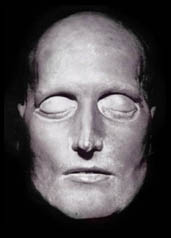 Mask of Noverraz type
Mask of Noverraz type
"It is the case of the Bertrand mask pertaining to Prince Napoleon, probably made in 1821, and of the mask exhibited at Malmaison, which would have been made in 1822 [note: G-d only knows!]. To finish on the helenian-type masks, it is necessary to mention the Gilley masks which would have been tests made by Antommarchi prior to the traditional one. These masks of Antommarchi type were quickly disputed because, among other reasons, of their lack of resemblance to the effigy of the Emperor at the end of his life [let us underline this statement]. Consequently, other masks appeared, and among the principal forgeries of the mask, it is necessary to mention the following types..."
Is it so? Because the other masks, those just previously mentioned, would be genuine masks? We have just demonstrated that it is not the case, that the Burguersh mask, as believed to be made from the prototype of the Antommarchi mask, is the mask of another individual than Napoleon: it cannot be different! However, let us examine them, as colonel Chaduc proposes it, because the true death mask of the Emperor could be well among them!
"The mask of the Arnott type: we know three specimens of this type, and it would have been made from a wax print taken clandestinely (without the knowledge of the members of the suite of Napoleon) by Doctor Arnott in the night from the 5th to the 6th of May. It is very dissimilar to the Antommarchi type."
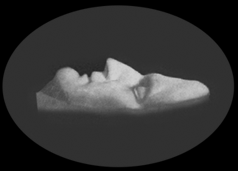 Mask of Arnott type
Mask of Arnott type
Indeed! It is dissimilar because it is much more resembling to Napoleon than the ones of Antommarchi type; photographed by Badié in 1861 in The Tuileries. Napoleon III considered it to be the genuine mask – and as his uncle Jerome - and this is a proof that the Bonaparte family defied the "official" mask! Personally, I think that it is “genuine false” one: Arnott, knowing the imposture made by Antommarchi, decided to benefit from it; he would have bribed the young Count Leon (a natural child of Napoleon) to mould his face and to pass it for that of his father. For the moment, this remains an assumption: what is proven is the presence of Leon in Germany in 1827, date when the Arnott mask appears...
”The mask of the count Pasolini: it would have come from a St. Helena mould carried out clandestinely by the servants of the Emperor."
This has no interest: this mask is made from papier-mâché soaked into milk; if this mask was genuine, the result is nevertheless rather nil!
"The mask from the Royal United Service Museum of London comes from an impostor who called himself “Prince” Louis Charles of Bourbon. This mask has a completely unknown source, and introduces a chubby and toothless character, with no resemblance to Napoleon in 1821 whatsoever."
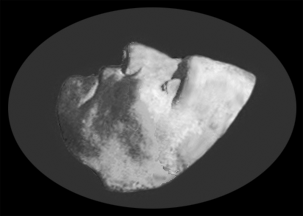
 Copy of Burton mask,
Copy of Burton mask,
deposited in Royal United Service Institute (RUSI), from 1947 to 1973.
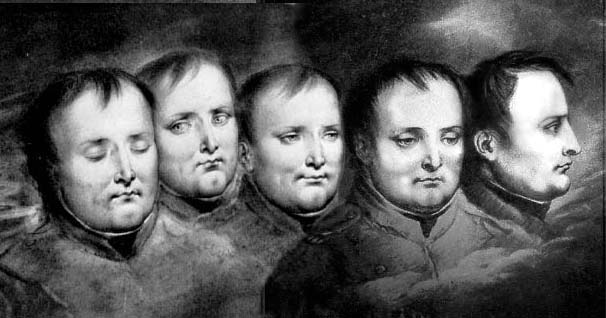 Napoleon by Girodet
Napoleon by Girodet
This statement is a new height in misinformation and bad faith!
This mask was given by Charles Alder in 1952 to England. The British authorities "deposited" it at the Royal United Service Museum. When this institution transformed itself into Royal United Service Institution, we lost track of the mask around 1972... Charles Alder obtained it from a swindler, the so-called "Prince", of his true name William Reeves. This person stated to have acquired the mask "by an exchange or purchase of the late Victor Masséna, Prince d'Essling"! Mr. Alder assured to have had hands on the signed documents from Prince Masséna and authenticating the relic. In any case, the source of this mask is far from being completely unknown, even if it is debatable...
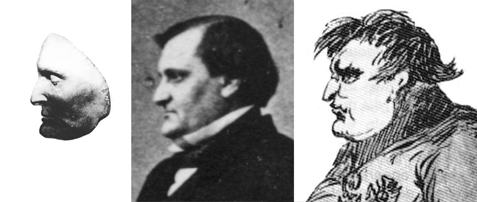 - the Mask of London the jaw replaced, - Profile of Plon-Plon, - Profile of Napoleon at St. Helena
- the Mask of London the jaw replaced, - Profile of Plon-Plon, - Profile of Napoleon at St. Helena
Likewise, the opinion of the successive Conservateurs at Les Invalides is very debatable - not to say more – and they fail to see any resemblance between the aspect of this "death mask of Napoleon" and the Emperor’s. However, this resemblance is indubitable, in particular with the photographs of Jerome (brother of Napoleon) and of his son called "Plon-Plon" (nephew of Napoleon). In addition, a complete investigation of this matter was carried out in co-operation with Albert Martin, Webmaster of napoleon1er.com, which establishes, in particular by using the morphing techniques, the coherence of this mask with the "Lebendmaske", property of the Rolletmuseum in Baden, Austria. Computer age is ruthless for the theory still defended today by Lt-Colonel Chaduc. It is undoubtedly a reason why my letter to General Devaux, director at the Musée de l’Armée in Paris, that establishes these facts remained unanswered to date! Thus let us see what are the official thoughts about the "Lebendmaske":
"The mask of the museum of Baden allegedly offered by Antommarchi to the ex-empress Marie-Louise, who remarried with Count Neipperg, would have been used as a toy by their children. It is then saved by Doctor Rollet and deposited by his son with the museum of Baden. But this plaster mask does not evoke of anything a death and rather seems to be moulded from a subject in full health of forty years." »
 The mask of the museum of Baden
The mask of the museum of Baden
Indeed! But it is not to the children of Neipperg and Marie-Louise that this mask was used as a toy. It is to the children of their intendant, Baron de Werklein, who had orders to keep it away from the curiosity of the “Eaglet”, the unfortunate Napoleon II. With Albert Martin, we think that this mask could have been made while Napoleon was still alive, probably at the time of his exile in Elba... I must admit that initially I hardly saw any resemblance to the Emperor. The computer-assisted superposition of the RUSI death mask and of the Lebendmaske opened my eyes: they have an even bone structure, an even shape of the eyes, an even location of the jaw (except when viewed in profile, where it is a little less true). All these results were communicated to the authorities; they have however never taken any action to investigate further! Their will to avoid such investigation is made clear...
"A study of the various masks reveals that the Antommarchi type mask is the most authentic even if it presents some anomalies
[it is an euphemism!].
People have reproached his lack of resemblance, but it should not be forgotten that all witnesses in 1821 agreed that the Emperor appeared younger by the time of his death
[note: this was immediately after the death, and still 6 hours after death (he then seemed to be 30-year old); but, in the morning of May 6th at 8 a.m., he seemed to be 40-year old; and, in the same evening at 4 p.m., more than his age (52 year-old): then, on May 7th at 4 p.m. - at the time of the taking of the mask – he must have certainly seemed more than 60-year old: it is exactly the aspect of the RUSI death mask! ]. . D’ailleurs,
Moreover, initially Antommarchi refused to take the print of Napoleon judging it poorly resembling
[this argument is grotesque; it was certainly more resembling 12 hours after death than 48 hours later, when Antommarchi took the print with Dr Burton! It is because Antommarchi did not initially have a good plaster that he gave up trying a moulding on May 6th...].
...]. It is only after that Burton decided to do it that he participated in the operation by fear of being excluded from this project
project [Lt-Colonel Chaduc thus admits that it is Burton and not Antommarchi who is the author of the facial part]. .
In addition, it should not be forgotten that the mask carried out by Antommarchi is the result of a moulding only for the central part, while the remainder results from a modelling."
»
So many contradictions in this conclusion, and so many untrue statements! We believe to have made justice to this absurd thesis of the "central part", an invention entirely made up by Baron de Veauce who put it himself in doubts of plausibility... A diligent investigation, entrusted to a scientific and certified organization, would inevitably result in recognizing the fraud and treachery! What is the reason for holding the stating of this truth? Because, to tell this truth would mean the existence of another fraud, of another treachery, of which the one of the mask is only like the emerged part of the iceberg: the non-presence of Napoleon in the red porphyry coffin under the dome at Les Invalides!
Under these conditions, My Colonel, I urge you to put an end to the past mistakes and to appoint a qualified organization (CNRS or other) to carry out the scientific investigation which is essential to establish the facts. Meanwhile, I remain your most faithful servant.
.
_______________________________________________
"Contrary to Antoine de Caunes,
Bruno Roy-Henry believes that Saliceti was the natural father of Cipriani (p.192 of its book).
An additional clue…
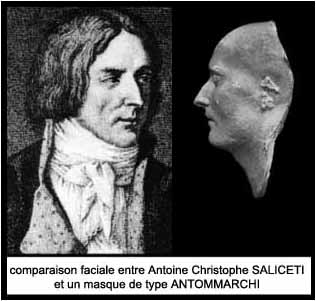 Saliceti and Cipriani: father and son?
Saliceti and Cipriani: father and son?
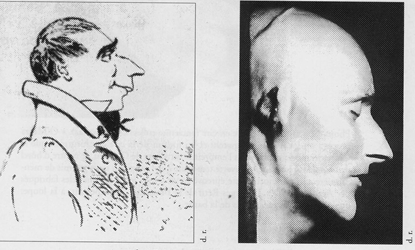 Superposition of the caricature and the mask of Antommarchi
Superposition of the caricature and the mask of Antommarchi
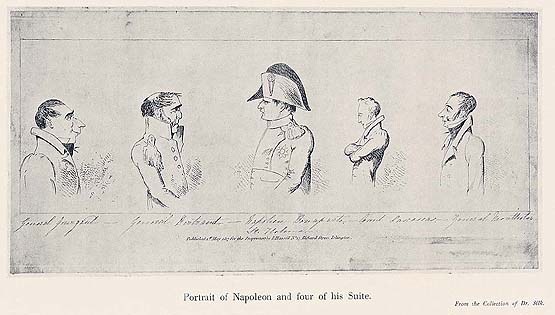 Portrait of Napoleon and four officers of his suite
Portrait of Napoleon and four officers of his suite
|










